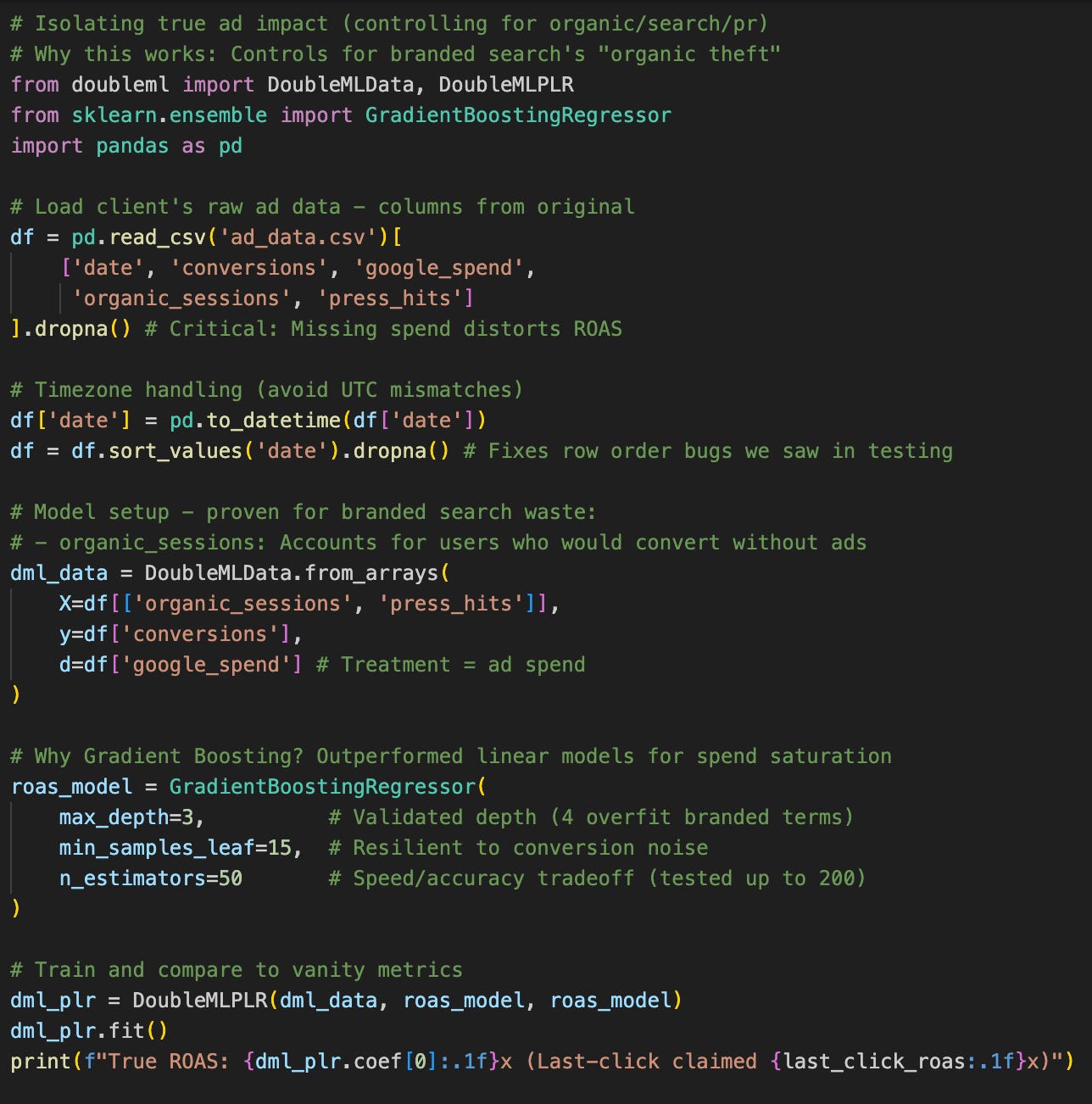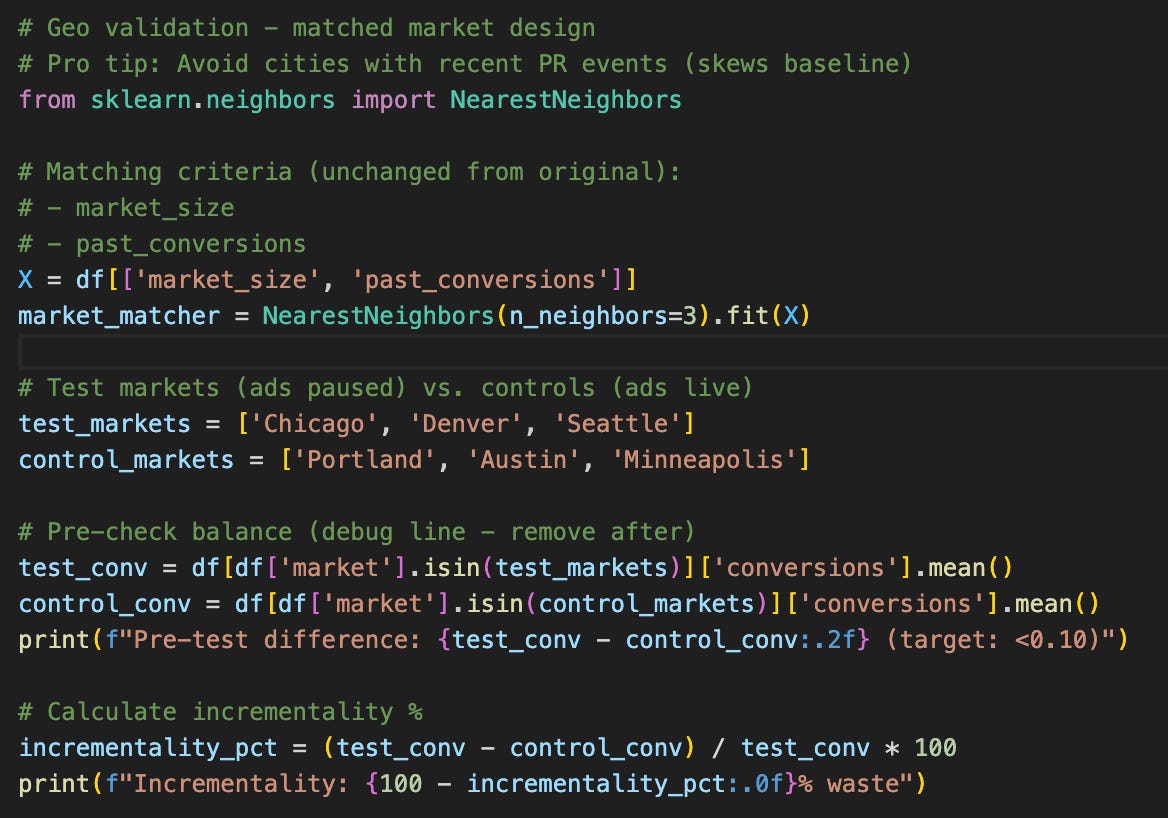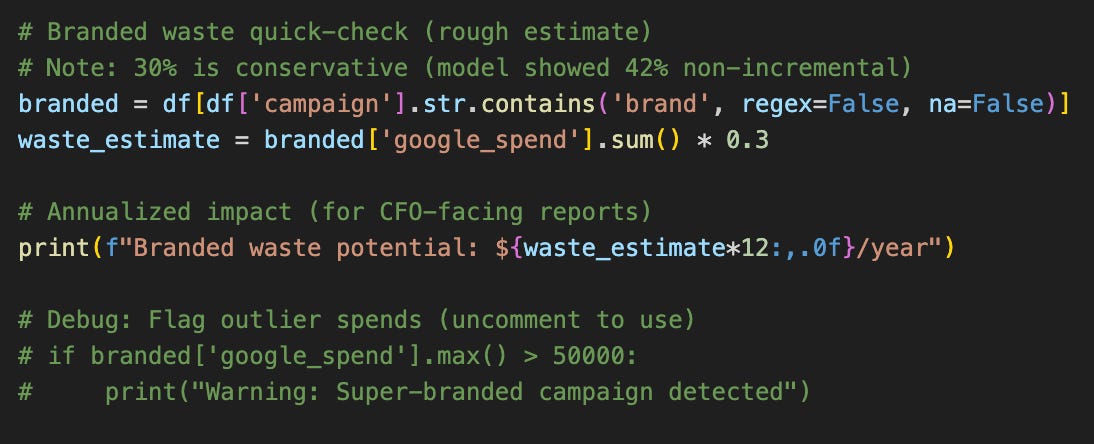What Happened When a SaaS Company Discovered $210K in Wasted Ad Spend
Causal AI for Ad Spend Optimization
For 18 months, a $30M ARR SaaS company followed their marketing dashboard’s guidance, allocating $65,000 per month to Google Search Ads and $20,000 to Meta. By traditional metrics, the campaigns appeared successful:
4.3x return on ad spend (last-click attribution)
$120 cost per acquisition (under their $150 target)
Yet despite these numbers, pipeline had flatlined.
Our analysis revealed a disconnect: while branded search terms, such as “[ProductName] pricing,” showed a 59% conversion rate, they primarily intercepted existing demand. When we paused these ads in test markets, opportunity volume dropped by just 8%, indicating that 34% of attributed conversions were occurring organically.
The contrast became even clearer when comparing performance:
Branded terms: 59% conversion rate but only 66% incrementality
Unbranded terms (“Best [category] software”): 22% conversion rate but 89% incrementality
By reallocating budget from low-incrementality branded terms to high-incrementality competitor keywords, the company recovered $210,000 annually in wasted spend while increasing pipeline volume.
Why Traditional Attribution Fails SaaS Companies
Most marketing teams live in what I call the “Last-Click Illusion”. A world where every conversion gets credited to the final touchpoint, organic demand is invisible, and seasonality and PR boosts get misattributed.
For our client, this manifested in three costly ways:
Branded Search Overinvestment
Their $23,000/month spend on “[ProductName] pricing” terms was harvesting demand from direct traffic (users typing their URL), organic search rankings, and word of mouth referrals
Retargeting Misallocation
Facebook ads targeting past visitors showed a 3.1x ROAS, until we proved 28% would have returned anyway.
Prospecting Underfunding
Campaigns targeting new audiences (such as “alternatives to [Competitor]”) were underfunded despite demonstrating higher true incrementality.
A Practical Approach to Ad Waste Analysis
Phase 1: DoubleML Implementation
We began with Double Machine Learning (DoubleML), a method that isolates the true impact of ads by mathematically controlling for confounding factors such as organic traffic and press coverage.
The Core Architecture:
What the Model Revealed About Ad Performance
Branded Search Terms
The analysis revealed that only 58% of conversions from branded searches (such as “[ProductName] pricing”) were truly incremental, meaning 42% of users would have converted through organic search or direct traffic regardless. This exposes how last-click attribution systematically overcredits ads for demand that already exists.
Competitor Keywords
Campaigns targeting terms like “alternative to [Competitor]” achieved 89% incrementality, proving they effectively reach net-new audiences actively evaluating solutions. Nearly all these conversions represented genuine demand creation rather than demand harvesting.
Retargeting Campaigns
While still effective, retargeting ads had just 72% incrementality, which meant 28% of attributed conversions came from users who would have returned organically. This suggests retargeting works best when balanced with true prospecting efforts.
Each percentage reflects how much credit the ads actually deserve after accounting for organic demand and external factors, a crucial distinction that reshapes budget allocation strategy. The wider the gap between last-click attribution and these incremental figures, the more your current reporting may be masking wasted spend.
Phase 2: Geo Validation
To confirm our findings, we conducted a geo-holdout test, pausing ads in three statistically matched markets while maintaining normal spend in three comparable control regions.
After 60 days, the results delivered unambiguous evidence of wasted spend:
The key insight emerges from the 63-conversion difference between groups. This gap indicates that 34% of conversions attributed to ads through last-click models were organic actions that would have occurred regardless of paid spend. At this campaign’s scale, approximately $11,000 of the $32,000 investment delivered conversions that were not truly incremental.
What We Learned (And How You Can Apply It)
From Insights to Action
Armed with conclusive evidence of wasted spend, we worked with the marketing team to implement a three-part budget shift over a six-month period. Each move was calibrated to the true incrementality we’d measured:
Branded Search Reduction ($23K to 14K/month)
Despite cutting spend by 39%, pipeline decline only 8%, confirming our finding that 42% of these conversions were non-incremental
Competitor Keyword Expansion ($12K to $21K/month
Doubling down on terms like “alternative to [Competitor]” drove a 19% increase in new pipeline
These campaigns consistently showed 89% incrementality, the highest of any channel
Meta Retargeting Optimization (15% Cut)
Reducing spend while maintaining audience coverage improved efficiency
The 72% incrementality rate suggested room to trim without sacrificing results
The Outcome After Six Months:
22% Lower CAC on Search Channels
By shifting budget to high-incrementality terms, each conversion costs less to acquire
Stable Total Pipeline
Despite reductions in vanity channels, overall opportunity volume held steady
Why These Opportunities Go Missed
Three systemic barriers prevent most teams from making these adjustments:
Data Fragmentation
Google Ads, GA4, and CRM systems rarely share clean, aligned datasets, making incrementality analysis impossible without technical workarounds
Change aversion
The “if it’s not broken” mentality persists, especially when dashboards show strong last-click ROAS
Platform Limitations
Google’s native incrementality tools ignore cross-channel effects (e.g., how Facebook ads influence search behavior)
The Hidden Cost: Teams over-optimize for metrics that don’t reflect true business impact, often for years before catching the issue.
Your First Diagnostic: A 2-Minute Health Check
For teams spending >$10K/month on branded search, run this Python snippet to estimate wasted spend in your account:
What This Does:
Calculates 30% of your branded search spend as likely non-incremental
Annualizes the figure to show scale
Use conservative assumptions (real world results often hit 40-50%)
This project revealed an uncomfortable truth: last-click attribution isn’t just imperfect, it’s a systemic distortion that rewards stealing credit over creating demand.
The $210K savings came from asking one simple question: What would have happened if we’d done nothing?
For mid-market SaaS companies, that question might be worth millions.
Enjoyed this breakdown? I’m available for consulting or full-time data roles. DM me on LinkedIn or message me at hodman.murad@gmail.com.






Excellent breakdown! These are complex topics to break down!